Climate of chaos: the suffocating firestorm engulfing Australia
The death toll from the unprecedented crisis has reached eight and sparked an apology from the prime minister

Adam Morton@adamlmorton
Fri 20 Dec 2019
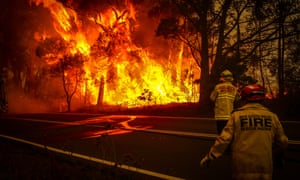
Firefighters were battling more than 200 fires as a heatwave engulfing Australia pushed temperatures in the south into the mid-40s. Photograph: David Gray/Getty Images
Even by the standards of 2019, with an Australian public increasingly conditioned to the threat of unprecedented bushfires and and warnings of record-breaking heat, this has been a week unlike those before it.
On Friday, firefighters were battling more than 200 fires across five states as a heatwave engulfing the country pushed temperatures in the south into the mid-40s, and Sydney and other centres were enveloped in a smoke that health professionals warned had been at hazardous levels for nearly a month. Strong winds pushed the smoke 900km south, where it also blanketing Melbourne.
The human cost was emphasised with the death of two firefighting volunteers, both young fathers, who were killed when their truck rolled as they helped defend villages south-west of Sydney. It brought the confirmed fire season death toll to eight. More than 800 homes and buildings have been destroyed in New South Wales alone.
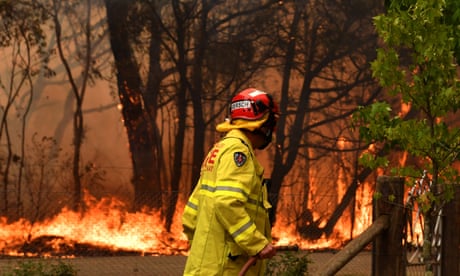
Australia records its hottest day ever – one day after previous record
The escalating crisis moved the prime minister, Scott Morrison, to apologise and promise to return early from a Hawaiian family holiday as he faced rising criticism for being absent during a disaster without informing the public he was taking leave. Morrison’s office had earlier denied to journalists that he was in Hawaii.
Until Tuesday, Australia’s hottest day on record had been in January 2013, when the average maximum temperature across the continent was 40.3C. By Thursday, that mark had been beaten three days straight. The new record of 41.9C (107.4F), set on Wednesday, was a full 1.6C hotter than the old benchmark.
Conditions were expected to worsen on Saturday in New South Wales, the site of the majority of the fires, as it was hit by the centre of a mass of hot air rolling across the continent. Authorities warned, with several areas including suburban Sydney facing catastrophic fire conditions of expected temperatures up to 47C, the hottest all year, and gusting inland winds approaching 40kmh, people should not assume firefighters could save them.
The extraordinary heatwave has been partly driven by natural factors – the strongest Indian Ocean dipole event on record that has dragged moisture away from the continent, and atmospheric warming above Antarctica, which heated up the areas worst affected by fire along the east coast – but scientists say it cannot not be divorced from the more than 1C rise in average temperatures due to increased atmospheric greenhouse gases.
According to Sarah Perkins-Kirkpatrick, from the University of New South Wales’ climate change research centre, “everything about this is unprecedented”. She says it is hard, after years researching and speaking to the media about the link between emissions and extreme heat, to find the right words to describe what the country is now experiencing.
“Climate scientists have been banging on about it longer than I’ve been alive,” Perkins-Kirkpatrick says. “We all knew at some point that everything would come together in a perfect storm to make people fully realise climate change is here and now it is. We aren’t surprised, but we are equally shocked and saddened.”
Even by the standards of 2019, with an Australian public increasingly conditioned to the threat of unprecedented bushfires and and warnings of record-breaking heat, this has been a week unlike those before it.
On Friday, firefighters were battling more than 200 fires across five states as a heatwave engulfing the country pushed temperatures in the south into the mid-40s, and Sydney and other centres were enveloped in a smoke that health professionals warned had been at hazardous levels for nearly a month. Strong winds pushed the smoke 900km south, where it also blanketing Melbourne.
The human cost was emphasised with the death of two firefighting volunteers, both young fathers, who were killed when their truck rolled as they helped defend villages south-west of Sydney. It brought the confirmed fire season death toll to eight. More than 800 homes and buildings have been destroyed in New South Wales alone.

Australia records its hottest day ever – one day after previous record
The escalating crisis moved the prime minister, Scott Morrison, to apologise and promise to return early from a Hawaiian family holiday as he faced rising criticism for being absent during a disaster without informing the public he was taking leave. Morrison’s office had earlier denied to journalists that he was in Hawaii.
Until Tuesday, Australia’s hottest day on record had been in January 2013, when the average maximum temperature across the continent was 40.3C. By Thursday, that mark had been beaten three days straight. The new record of 41.9C (107.4F), set on Wednesday, was a full 1.6C hotter than the old benchmark.
Conditions were expected to worsen on Saturday in New South Wales, the site of the majority of the fires, as it was hit by the centre of a mass of hot air rolling across the continent. Authorities warned, with several areas including suburban Sydney facing catastrophic fire conditions of expected temperatures up to 47C, the hottest all year, and gusting inland winds approaching 40kmh, people should not assume firefighters could save them.
The extraordinary heatwave has been partly driven by natural factors – the strongest Indian Ocean dipole event on record that has dragged moisture away from the continent, and atmospheric warming above Antarctica, which heated up the areas worst affected by fire along the east coast – but scientists say it cannot not be divorced from the more than 1C rise in average temperatures due to increased atmospheric greenhouse gases.
According to Sarah Perkins-Kirkpatrick, from the University of New South Wales’ climate change research centre, “everything about this is unprecedented”. She says it is hard, after years researching and speaking to the media about the link between emissions and extreme heat, to find the right words to describe what the country is now experiencing.
“Climate scientists have been banging on about it longer than I’ve been alive,” Perkins-Kirkpatrick says. “We all knew at some point that everything would come together in a perfect storm to make people fully realise climate change is here and now it is. We aren’t surprised, but we are equally shocked and saddened.”
and Geoffrey Keaton at a memorial at the Horsley Park
Rural Fire Brigade. They were in a truck convoy near
the town of Buxton when a tree fell into their path,
prompting the vehicle to roll off the road, with both men
dying at the scene. Photograph: Bianca de Marchi/AAP
The worsening conditions have come as the Morrison government is feeling heightening pressure at home and abroad for failing to acknowledge and address the climate crisis.
Morrison’s reputation on climate change was forged in early 2017, when he brandished a piece of coal in parliament at the opposition Labor party, telling them, and the public, it was not something that should invoke fear.
As the bushfire crisis worsened over the past month, the prime minister dismissed suggestions that anything Australia did could limit the impact of global heating on the fire threat and refused to meet with former emergency services chiefs who wanted to discuss the climate crisis. It prompted accusations he was failing to show leadership on a national disaster.
The issue came to a head before Morrison headed overseas when, with Sydney shrouded in smoke and its famous harbour near invisible, he called a press conference to discuss legislation to enshrine religious institutions’ right to discriminate against staff, with the bushfires only belatedly raised in the questions that followed.
The ensuing criticism led to a statement two days later in which Morrison acknowledged the bushfires were an emergency and said he accepted the link between climate change and an extended fire season. He rejected criticism of his climate stance at the UN summit in Madrid, where Australia was repeatedly named as one of a handful of countries blocking more ambitious action, as baseless. Then he went overseas.
Australia bushfires factcheck: are this year's fires unprecedented?
What was not considered a significant news story, on the basis a prime minister is entitled to a holiday and the issue is the government’s policies, gained momentum as anger over his absence grew on social media. It culminated in a protest outside his Sydney residence, Kirribilli House, on Thursday.
The abrupt cancellation of Morrison’s holiday on Friday came after a picture was posted to Istagram showing the prime minister posing in Hawaii with other Australian tourists, who claimed to have shared a “few bevvies” with him.
In a written statement, he said he had brought forward his leave with his family as he would be travelling overseas on official business next month, but would now come home before his wife and daughters. In a subsequent interview on 2GB radio in Sydney, Morrison said he accepted his absence had “understandably caused a lot of anxiety”. He deeply regretted it.
David Littleproud, the emergency management minister, later said Morrison might have “retrospectively” not gone had he known how bad the bushfire crisis would be.
Critics said the crisis was already well known. In a special climate statement released amid this week’s heatwave, the Bureau of Meteorology said that as early as September most of the east of the continent was “primed for high fire danger ratings”. The three months of spring were the driest and second warmest on record.
At last count, the bushfires had destroyed at least 3.1m hectares in NSW and Queensland alone, an area larger than Belgium. In the process they had razed areas that do not usually burn, including rainforests, wet eucalypt forests and dried-out swamps, and are believed to have coupled with the atmosphere to create giant thunderstorm clouds.
The weather bureau says warmer and drier conditions are expected to continue into the new year. With the onset of the usual northern monsoon delayed, tropical rains are not expected until late January or into February.
“They’re ordinary, everyday individuals – like you and I – that go out and simply want to serve and protect and make a difference in their local community,” said the New South Wales rural fire service commissioner, Shane Fitzsimmons. “And they don’t ever go out in the knowledge that they might not come home from that shift.”
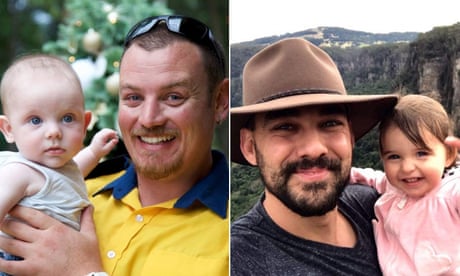
NSW bushfires: RFS names two firefighters killed south-west of Sydney
South Australia had its worst fire danger day of the summer so far on Friday as a combination of extremely high temperatures – reaching close to 50C in some parts of the state – and strong winds were followed by huge thunderstorms, which presented the potential for thousands of lightning strikes that could ignite further blazes.
There were multiple reports of homes and other buildings on fire in the worst blaze, at Cudlee Creek.
More than 100 fires are currently burning across NSW and half of them are not contained, including the “megafire” in Gospers Mountain, north-west of Sydney, that has been burning for almost two months and has so far destroyed more than 350,000 hectares.
Temperatures in much of NSW are expected to rise to the mid-40s on Saturday, which, combined with strong winds and intensely dry conditions, has led fire chiefs to warn people that fires could break out very quickly, destroying homes and endangering lives before emergency services could reach them.
“Do not put yourself in harm’s way tomorrow,” warned Rob Rogers, deputy commissioner of the NSW rural fire service on Friday. “We cannot guarantee to get firetrucks to you ... Don’t expect a fire truck, don’t expect a plane, don’t wait for a warning.”
Since this year’s fire season began, 800 dwellings have been lost in NSW alone, with fire chiefs warning it was inevitable that more homes would be destroyed on Saturday.
“I think that’s a fairly sure thing that we will lose homes somewhere tomorrow. It would be a miracle if we didn’t,” said Rogers.
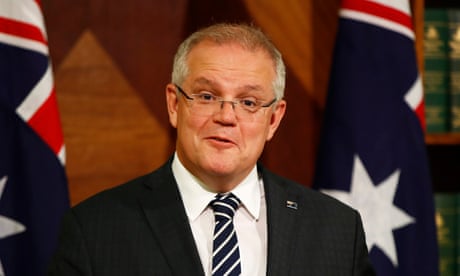
Scott Morrison apologises for taking holiday during Australia's bushfire crisis
At a joint press conference, Rogers and the NSW police deputy commissioner, Gary Worboys, also issued stark warnings to people planning on driving around the state on Saturday, the first day of NSW’s summer school holidays, saying their fear was that people would become stuck in cars along highways in heavy traffic as fire fronts closed in.
“People should consider staying at home tomorrow and make their travel arrangements for Sunday, Monday and Tuesday,” said Worboys. “They still have time in terms of Christmas Day. Tomorrow will be a difficult day.”
Many of the fires burning around Sydney are in popular holiday destinations, including the Blue Mountains to Sydney’s west, the central coast to the north and the Shoalhaven and Illawarra regions to the south. Sections of key roads out of Sydney will be closed tomorrow.
Residents in four towns in Victoria were urged to leave their homes immediately on Friday as two bushfires raged out of control.

Smoke haze over Melbourne on Friday.
Australia heatwave: records forecast to be broken as temperatures surge past 40C
Oodnadatta and Port Augusta forecast to reach 48C and Sydney’s western suburbs to hit 45C
Australia bushfires: total fire ban in NSW as heatwave temperatures forecast to soar – live
Calla Wahlquist @callapilla
Tue 17 Dec 2019

The worsening conditions have come as the Morrison government is feeling heightening pressure at home and abroad for failing to acknowledge and address the climate crisis.
Morrison’s reputation on climate change was forged in early 2017, when he brandished a piece of coal in parliament at the opposition Labor party, telling them, and the public, it was not something that should invoke fear.
As the bushfire crisis worsened over the past month, the prime minister dismissed suggestions that anything Australia did could limit the impact of global heating on the fire threat and refused to meet with former emergency services chiefs who wanted to discuss the climate crisis. It prompted accusations he was failing to show leadership on a national disaster.
The issue came to a head before Morrison headed overseas when, with Sydney shrouded in smoke and its famous harbour near invisible, he called a press conference to discuss legislation to enshrine religious institutions’ right to discriminate against staff, with the bushfires only belatedly raised in the questions that followed.
The ensuing criticism led to a statement two days later in which Morrison acknowledged the bushfires were an emergency and said he accepted the link between climate change and an extended fire season. He rejected criticism of his climate stance at the UN summit in Madrid, where Australia was repeatedly named as one of a handful of countries blocking more ambitious action, as baseless. Then he went overseas.
Australia bushfires factcheck: are this year's fires unprecedented?
What was not considered a significant news story, on the basis a prime minister is entitled to a holiday and the issue is the government’s policies, gained momentum as anger over his absence grew on social media. It culminated in a protest outside his Sydney residence, Kirribilli House, on Thursday.
The abrupt cancellation of Morrison’s holiday on Friday came after a picture was posted to Istagram showing the prime minister posing in Hawaii with other Australian tourists, who claimed to have shared a “few bevvies” with him.
In a written statement, he said he had brought forward his leave with his family as he would be travelling overseas on official business next month, but would now come home before his wife and daughters. In a subsequent interview on 2GB radio in Sydney, Morrison said he accepted his absence had “understandably caused a lot of anxiety”. He deeply regretted it.
David Littleproud, the emergency management minister, later said Morrison might have “retrospectively” not gone had he known how bad the bushfire crisis would be.
Critics said the crisis was already well known. In a special climate statement released amid this week’s heatwave, the Bureau of Meteorology said that as early as September most of the east of the continent was “primed for high fire danger ratings”. The three months of spring were the driest and second warmest on record.
At last count, the bushfires had destroyed at least 3.1m hectares in NSW and Queensland alone, an area larger than Belgium. In the process they had razed areas that do not usually burn, including rainforests, wet eucalypt forests and dried-out swamps, and are believed to have coupled with the atmosphere to create giant thunderstorm clouds.
The weather bureau says warmer and drier conditions are expected to continue into the new year. With the onset of the usual northern monsoon delayed, tropical rains are not expected until late January or into February.
No relief in sight from Australian bushfire crisis as toll from catastrophic blazes rises
Australia’s deadly bushfire emergency is set to continue on Saturday, as temperature records tumble and people are urged to delay travel
Kate Lyons@MsKateLyons
Fri 20 Dec 2019
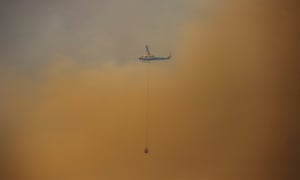
Australia’s deadly bushfire emergency is set to continue on Saturday, as temperature records tumble and people are urged to delay travel
Kate Lyons@MsKateLyons
Fri 20 Dec 2019

outskirts of Balmoral on Friday.
Photograph: Jessica Hromas/The Guardian
Australia is braced for another day of “catastrophic” fires on Saturday, with people urged to delay travel to holiday destinations, as soaring temperatures and strong winds led to further loss of life and homes on Friday.
The warnings come as Australian temperature records continued to tumble, with the country recording its three hottest days ever on Tuesday, Wednesday and Thursday.
In South Australia, one person died in a vehicle crash in the fire zone on Friday and another is unaccounted for, and four South Australian firefighters were treated for burns and smoke inhalation as the service was called to more than 120 fires.
Eight other people have been killed as a result of the fires during this fire season, which began well before the beginning of summer, including two volunteer firefighters who died as they were returning from fighting a fire near Buxton, south-west of Sydney, on Thursday night.
Geoffrey Keaton, 32, and Andrew O’Dwyer, 36, died when a tree fell into the path of their tanker, causing it to roll, as they were travelling in a convoy. Both men left behind partners and infant children.
Australia is braced for another day of “catastrophic” fires on Saturday, with people urged to delay travel to holiday destinations, as soaring temperatures and strong winds led to further loss of life and homes on Friday.
The warnings come as Australian temperature records continued to tumble, with the country recording its three hottest days ever on Tuesday, Wednesday and Thursday.
In South Australia, one person died in a vehicle crash in the fire zone on Friday and another is unaccounted for, and four South Australian firefighters were treated for burns and smoke inhalation as the service was called to more than 120 fires.
Eight other people have been killed as a result of the fires during this fire season, which began well before the beginning of summer, including two volunteer firefighters who died as they were returning from fighting a fire near Buxton, south-west of Sydney, on Thursday night.
Geoffrey Keaton, 32, and Andrew O’Dwyer, 36, died when a tree fell into the path of their tanker, causing it to roll, as they were travelling in a convoy. Both men left behind partners and infant children.
“They’re ordinary, everyday individuals – like you and I – that go out and simply want to serve and protect and make a difference in their local community,” said the New South Wales rural fire service commissioner, Shane Fitzsimmons. “And they don’t ever go out in the knowledge that they might not come home from that shift.”

NSW bushfires: RFS names two firefighters killed south-west of Sydney
South Australia had its worst fire danger day of the summer so far on Friday as a combination of extremely high temperatures – reaching close to 50C in some parts of the state – and strong winds were followed by huge thunderstorms, which presented the potential for thousands of lightning strikes that could ignite further blazes.
There were multiple reports of homes and other buildings on fire in the worst blaze, at Cudlee Creek.
More than 100 fires are currently burning across NSW and half of them are not contained, including the “megafire” in Gospers Mountain, north-west of Sydney, that has been burning for almost two months and has so far destroyed more than 350,000 hectares.
Temperatures in much of NSW are expected to rise to the mid-40s on Saturday, which, combined with strong winds and intensely dry conditions, has led fire chiefs to warn people that fires could break out very quickly, destroying homes and endangering lives before emergency services could reach them.
“Do not put yourself in harm’s way tomorrow,” warned Rob Rogers, deputy commissioner of the NSW rural fire service on Friday. “We cannot guarantee to get firetrucks to you ... Don’t expect a fire truck, don’t expect a plane, don’t wait for a warning.”
Since this year’s fire season began, 800 dwellings have been lost in NSW alone, with fire chiefs warning it was inevitable that more homes would be destroyed on Saturday.
“I think that’s a fairly sure thing that we will lose homes somewhere tomorrow. It would be a miracle if we didn’t,” said Rogers.

Scott Morrison apologises for taking holiday during Australia's bushfire crisis
At a joint press conference, Rogers and the NSW police deputy commissioner, Gary Worboys, also issued stark warnings to people planning on driving around the state on Saturday, the first day of NSW’s summer school holidays, saying their fear was that people would become stuck in cars along highways in heavy traffic as fire fronts closed in.
“People should consider staying at home tomorrow and make their travel arrangements for Sunday, Monday and Tuesday,” said Worboys. “They still have time in terms of Christmas Day. Tomorrow will be a difficult day.”
Many of the fires burning around Sydney are in popular holiday destinations, including the Blue Mountains to Sydney’s west, the central coast to the north and the Shoalhaven and Illawarra regions to the south. Sections of key roads out of Sydney will be closed tomorrow.
Residents in four towns in Victoria were urged to leave their homes immediately on Friday as two bushfires raged out of control.

Smoke haze over Melbourne on Friday.
Photograph: James D Morgan/Getty Images
Thick smoke also continued to blanket the east of the country, including Australia’s largest cities, Sydney and Melbourne, on Friday, prompting health warnings for residents.
Political pressure on the prime minister also mounted on Friday, with Scott Morrison apologising for going on holiday while Australia was in the grip of an extended bushfire crisis.
“I deeply regret any offence caused to any of the many Australians affected by the terrible bushfires by my taking leave with family at this time,” Morrison said.
Morrison later confirmed the holiday was in Hawaii, seeking to explain the trip’s secrecy by suggesting he had tried to give his daughters “a bit of a surprise”, despite several reporters stating the prime minister’s office had denied reports he was in Hawaii after he and his family had arrived.
Michael McCormack has served as acting prime minister since Monday, declaring his hometown of Wagga Wagga was the nation’s capital, while Morrison copped bad press for his holiday.
Additional reporting by Paul Karp
Thick smoke also continued to blanket the east of the country, including Australia’s largest cities, Sydney and Melbourne, on Friday, prompting health warnings for residents.
Political pressure on the prime minister also mounted on Friday, with Scott Morrison apologising for going on holiday while Australia was in the grip of an extended bushfire crisis.
“I deeply regret any offence caused to any of the many Australians affected by the terrible bushfires by my taking leave with family at this time,” Morrison said.
Morrison later confirmed the holiday was in Hawaii, seeking to explain the trip’s secrecy by suggesting he had tried to give his daughters “a bit of a surprise”, despite several reporters stating the prime minister’s office had denied reports he was in Hawaii after he and his family had arrived.
Michael McCormack has served as acting prime minister since Monday, declaring his hometown of Wagga Wagga was the nation’s capital, while Morrison copped bad press for his holiday.
Additional reporting by Paul Karp
Australia heatwave: records forecast to be broken as temperatures surge past 40C
Oodnadatta and Port Augusta forecast to reach 48C and Sydney’s western suburbs to hit 45C
Australia bushfires: total fire ban in NSW as heatwave temperatures forecast to soar – live
Calla Wahlquist @callapilla
Tue 17 Dec 2019

NSW has been placed under a total fire ban from midnight
Tuesday to midnight Saturday as Australia is hit by a
heatwave that will see temperatures nudge 50C in some
areas and 45C in western Sydney. Photograph: Dave Hunt/AAP
December heat records are expected to tumble in Australia from Wednesday as a heatwave moves across South Australia to Victoria and New South Wales.
Temperatures are forecast to peak in Victoria and South Australia on Friday, with Oodnadatta and Port Augusta to reach 48C (118F), and peak in NSW on Saturday.
NSW has been placed under a total fire ban from midnight on Tuesday to midnight on Saturday as firefighters battle to contain more than 100 fires burning around the state, including the 400,000-hectare (990,000-acre) Gospers Mountain megafire in Wollemi national park in the Blue Mountains.
Smoke from this fire is forecast to lay thick over Sydney on Wednesday morning, but will shoot up to 3km up into the atmosphere on Thursday when the heatwave reaches western Sydney. Penrith is forecast to reach 44C on Thursday and 45C on Saturday, while the eastern suburbs of Sydney will reach 39C on Thursday and 35C on Saturday.
Extreme fire danger is forecast for greater Sydney, the Illawarra and the southern ranges on Thursday.

'Hugely disappointed' emergency chiefs to hold bushfire summit with or without PM
Tibooburra, a small town in the far north-west of NSW, has been above 40C since Monday and is expected to remain above that temperature until Christmas Day.
“This is blowing [December records] out of the water,” said Rob Taggart, senior forecaster with the Bureau of Meteorology in Sydney.
Some of the official weather stations in NSW, such as the Bathurst agricultural station, have records dating back 108 years. The hottest ever December day on record at that station is 38.9C on 27 December 1938, during a historic heatwave that wrought the deadly Black Friday bushfires on 13 January 1939.
The hottest temperature ever recorded at that station was 41.5C on 11 February 2017, a day of catastrophic fire danger on which the St Ivan fire burned 55,000 hectares of bush and farmland and destroyed 35 homes around Uarbry in the upper Hunter Valley.
“The forecast predicts that Bathurst is going to exceed that December record by a pretty big margin, with a forecast top of 41C,” Taggart said. “To be having these levels of temperatures at this time of year, not in the peak of summer but in mid-December, is pretty big.”
This year was on course to be Australia’s second hottest on record, behind 2013, based on average monthly temperature data from January to November. It would have sailed into second place had December temperatures been average.
“It is going to provide pretty tough competition for Australia’s warmest year on record,” Taggart said.
Three of the four hottest years on record in Australia have occurred in the past six years, and all have occurred in the past 15.
December heat records are expected to tumble in Australia from Wednesday as a heatwave moves across South Australia to Victoria and New South Wales.
Temperatures are forecast to peak in Victoria and South Australia on Friday, with Oodnadatta and Port Augusta to reach 48C (118F), and peak in NSW on Saturday.
NSW has been placed under a total fire ban from midnight on Tuesday to midnight on Saturday as firefighters battle to contain more than 100 fires burning around the state, including the 400,000-hectare (990,000-acre) Gospers Mountain megafire in Wollemi national park in the Blue Mountains.
Smoke from this fire is forecast to lay thick over Sydney on Wednesday morning, but will shoot up to 3km up into the atmosphere on Thursday when the heatwave reaches western Sydney. Penrith is forecast to reach 44C on Thursday and 45C on Saturday, while the eastern suburbs of Sydney will reach 39C on Thursday and 35C on Saturday.
Extreme fire danger is forecast for greater Sydney, the Illawarra and the southern ranges on Thursday.

'Hugely disappointed' emergency chiefs to hold bushfire summit with or without PM
Tibooburra, a small town in the far north-west of NSW, has been above 40C since Monday and is expected to remain above that temperature until Christmas Day.
“This is blowing [December records] out of the water,” said Rob Taggart, senior forecaster with the Bureau of Meteorology in Sydney.
Some of the official weather stations in NSW, such as the Bathurst agricultural station, have records dating back 108 years. The hottest ever December day on record at that station is 38.9C on 27 December 1938, during a historic heatwave that wrought the deadly Black Friday bushfires on 13 January 1939.
The hottest temperature ever recorded at that station was 41.5C on 11 February 2017, a day of catastrophic fire danger on which the St Ivan fire burned 55,000 hectares of bush and farmland and destroyed 35 homes around Uarbry in the upper Hunter Valley.
“The forecast predicts that Bathurst is going to exceed that December record by a pretty big margin, with a forecast top of 41C,” Taggart said. “To be having these levels of temperatures at this time of year, not in the peak of summer but in mid-December, is pretty big.”
This year was on course to be Australia’s second hottest on record, behind 2013, based on average monthly temperature data from January to November. It would have sailed into second place had December temperatures been average.
“It is going to provide pretty tough competition for Australia’s warmest year on record,” Taggart said.
Three of the four hottest years on record in Australia have occurred in the past six years, and all have occurred in the past 15.
“Australia has warmed by about 1.4C since pre-industrial times and that warming trend is increasing,” Taggart said. “So as climate scientists have been saying for 20 years, we can expect more frequent heatwaves, and more severe heatwaves, and this is certainly an example of that.”
Koalas in Blue Mountains rescued as blazes approach – as it happened
The southern parts of SA, from Port Lincoln to Mount Gambier, will also be under a total fire ban tomorrow, with extreme fire danger in the Yorke Peninsula, areas outside Adelaide, and the lower south-east.
A total fire ban will also be enforced in the Wimmera region of Victoria on Wednesday, where the danger rating has been set at severe. The rest of the state, including the Mallee region, which will see the top temperatures tomorrow with Mildura to reach 43C, has a fire-danger rating of very high.
Melbourne is forecast to reach 39C on Wednesday and 41C on Friday, when Mildura is forecast to experience its hottest ever December day of 47C.
“It’s going to be hot all the way through,” said Christie Johnson, duty forecaster with the Bureau of Meteorology in Victoria.

No comments:
Post a Comment